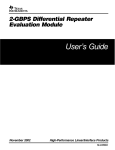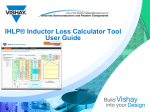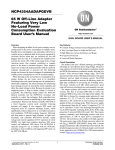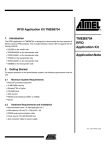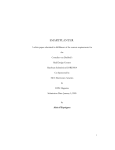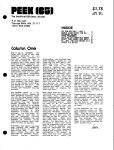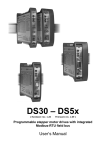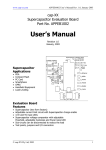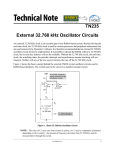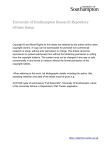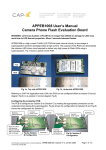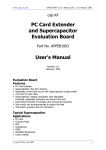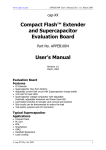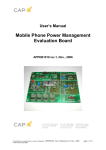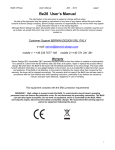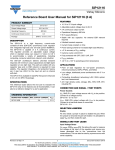Download - Cap-XX
Transcript
User’s Manual Camera Phone Flash Evaluation Board Dual Cell APPEB1007 All information contained herein is strictly confidential © CAP-XX Pty Limited 2005 APPEB1007 User Manual rev1.0, 31-May-2005 page 1 of 6 Camera Phone Flash Evaluation Board User’s Manual Board Features FLASH mode with adjustable voltage and current TORCH/MOVIE/GPRS mode with adjustable voltage and current VOUT/GND connector to evaluate GPRS Power Amplifier On-board or External triggering On-board or External white LEDs LED and inductor current measurement ability Auto run for flash or torch Quick Setup The following jumpers should be in place J1, J4, J5, J8, J9, J10, J12 and J15. Connect the positive terminal of a single cell Lithium Ion rechargeable battery (3.3V-4.2V) to any pin on J2 and connect the negative terminal to any pin of J3. The red LED (D2) should come on immediately. TORCH Flick the toggle switch (SW2) to the left (towards the TORCH pushbutton SW1). Pressing SW1 will now cause 100mA (factory set) to flow through each of the white LEDs (D5 & D6). With the factory setting of 100mA per white LED, SW1 can be held down continuously. FLASH Flick the toggle switch (SW2) to the right (towards the FLASH pushbutton SW3). Pressing SW3 will now cause 1A (factory set) to flow through each of the white LEDs (D5 & D6) for approximately 80ms. If the button is held down continuously the flash will retrigger approximately every 2.5s. This duty cycle is imposed due to the thermal constraints of the white LED. GPRS GPRS mode is the same as TORCH mode, ie flick the toggle switch (SW2) to the left (towards the TORCH pushbutton SW1). The factory set output voltage is 3.8V and it is available on the orange connector (TB1) to be connected to a Power Amplifier or other pulsed load. Circuit Description (refer to schematics at the end of this manual) Input Voltage The circuit is designed to operate from an external Li ion battery (4.2V-3.3V). Vbat is the node connected to the battery via J2. J2 is to be connected to battery positive terminal. Pins 1 and 2 of J2 are joined. J3 is to be connected to battery negative terminal. Pins 1 and 2 of J3 are joined. A current limiting MOSFET (M1) is not currently installed on the PCB and as such the bypass jumper (J15) needs to be installed. Indicating LED D2 is a red LED that indicates a source voltage is present. Buck/Boost Converter J1 needs to be jumpered for normal operation. This jumper has been included so a wire loop can easily be inserted to measure the inductor current. By measuring the inductor current and monitoring the voltage of pin 6 of U1 the average output current can also be determined. All information contained herein is strictly confidential © CAP-XX Pty Limited 2005 APPEB1007 User Manual rev1.0, 31-May-2005 page 2 of 6 The controller is an LTC3442 from Linear Technology. Its “Soft Start” and “Burst” features are not currently utilized and as such J4 and J5 need to be jumpered to disable these features. Inrush Current A discharged supercapacitor presents itself as a short circuit and therefore inrush current needs to be managed. The LTC3442 has an average input current limiting feature and this has been set to approximately 1.5Amps by selecting R11 = 47KΩ. FLASH MODE For FLASH mode, Vout is factory set to 4.5V. This voltage can be reduced by turning R21 (a 100k pot) anticlockwise. TORCH MODE The continuous current required for TORCH is << FLASH current (typically 200mA Vs 2A). Therefore the voltage dropped across the white LEDs will be less. To increase efficiency (and to reduce thermal stress on the current limiting MOSFET (M4)) Vout should also be reduced. Vout can be adjusted using R22 (a 1M pot). Vout is factory set to 3.8V. The FLASH mode voltage needs to be adjusted prior to the TORCH mode voltage because the FLASH setting affects the TORCH setting but not vice versa. If Jumper J12 is removed then the TORCH / GPRS mode voltage is the same as that set in Flash Mode above and R22 has no effect. GPRS MODE GPRS mode is the same as TORCH mode (factory set to 3.8V). The Vout setting (adjusted using R22) has to satisfy both the external Power Amplifer and have enough voltage headroom to drive the white LEDs in TORCH mode for the TORCH Mode current selected. Current Control FLASH MODE The FLASH current is factory set to 2.0 Amps (shared between two white LEDs). It can be reduced by turning R33 (10k pot) anti-clockwise. The current in a single white LED should not exceed 1 Amp so if only one LED is to be used then the FLASH current should be reduced to 1 Amp or less prior to driving the single LED. The FLASH current needs to be adjusted prior to the TORCH current because the FLASH setting affects the TORCH setting but not vice versa. TORCH MODE The TORCH current is factory set at 200mA. It can be reduced by turning R34 (2k pot) anticlockwise or increased by turning R34 clockwise. Care should be taken not to increase Torch mode current > 400mA total (200mA per LED) so as not to overheat and destroy the LEDs. GPRS MODE The maximum average load current is determined by the average input current limit which is set at 1.5Amps on the LTC3442 Buck/Boost controller. Assuming 85% efficiency, maximum average load current = 1.5A x Vbat/(Vout in TORCH mode) x 85%. Providing the DC:DC converter provides sufficient average load current, the supercapacitor will provide the peak currents. All information contained herein is strictly confidential © CAP-XX Pty Limited 2005 APPEB1007 User Manual rev1.0, 31-May-2005 page 3 of 6 External FLASH LED An External white LED (or other load) can be connected to the board across Jumper J7 (pin2 is +ve). When doing this, also remove Jumpers J8 and J9 to disconnect the on-board LEDs (D5 & D6). Alternatively, more white LEDs (Lumileds LXCL-PWF1) can be connected in parallel to D5 & D6 across J7 with Jumpers J8 and J9 in place. External FLASH/TORCH/GPRS MODE Control An external control signal (3V) connected to pin 2 of J13 will select TORCH MODE. Flash PulseTimers/External FLASH Pulse Control There are two on-board 555 timers. One generates the FLASH on-time and the other generates the off-time. The FLASH trigger from these timers is connected to the Current Control circuitry via J10. J10 is jumpered for normal operation. An external triggering circuit can be connected by removing the jumper from J10 and connecting the external signal to pin 1 of J10. There is a 33k pull down resistor on this pin. A logic high signal on this pin will take a FLASH. Make sure that this signal is < 100ms long and does not occur for at least another 2s otherwise the thermal limits of the white LEDs will be violated and they will be destroyed. Auto Flash If J14 is jumpered then the two 555 timers will be continuously triggered to generate an 80ms flash pulse every 2.5s. Jumpering J14 has the same effect as pressing SW3 continuously. Further Information CAP-XX will be pleased to provide further information on the applications described here, and on the use of supercapacitors in any application. Please use the contact details on the header page, or visit the CAP-XX web site. All information contained herein is strictly confidential © CAP-XX Pty Limited 2005 APPEB1007 User Manual rev1.0, 31-May-2005 page 4 of 6 Schematics J15 2 1 FET Bypass 8 7 6 5 805 R1 Vbat J2 1 1 2 3 22m 2 C4 4u7 805 Vbattery C5 4u7 805 C6 4u7 805 R5 4 J3 1 2 805 47n GND R16 C17 56n 805 1 U3 LM4041 3 6 1k8 805 D2 D3 LSR976 805 LYR976 805 R13 470 805 7 + Vbat U4 1 2 3 TS1852 R15=R19/(1.22/I/22m-1) 5 4 C20 100n 805 C19 4u7 805 LM4041 3 1 2 C21 4u7 805 L1 Inductor Current 1 2 1 J4 C14 4u7 805 C15 ? 805 R11 ? 805 Vout SW1 SW2 Vin Vout *SHDN/SS FB Rlim VC Rt Burst Sgnd Pgnd R12 ? 805 R4 300k 805 805 R8 DNP R2 DNP 805 C7 DNP 805 C2 4u7 805 C3 4u7 805 R3 22k 805 C8 DNP 805 R14 110k 805 Vout Vout 1 J5 Vin J6 1 Burst DIS R20 805 M3 ? 2 Burst EN R25 805 33k All information contained herein is strictly confidential APPEB1007 User Manual rev1.0, 31-May-2005 R17 805 33k 2 R18 ? 805 CAP-XX R6 22k 805 C16 805 ? C18 ? 805 C1 R21 3 100k T93YB 2 1 FDV301N SOT23 page 5 of 6 M2 FDV302P SOT23 3 R23 330k 1 805 2 D1 6 8 12 11 7 5 CON1 GPRS 1 LTC3442 U1 4 9 1 10 2 3 R7 ? 805 MBRO520LT1 SOD123 J1 heat C12 4u7 805 2 C11 4u7 805 SS DIS C10 4u7 805 1 C9 100u TPSC 2 4u7 IHLP 13 Vin 1V2 U5 Vbat 2 D4 BZX84C SOT23 © CAP-XX Pty Limited 2005 R26 33k 805 1 R10 1k 805 3V Vin Vout GND *Shdn Bypass TC1185 SOT23-A R24 10k 805 3 R9 1k 805 C13 OUT 5 R19 33k 805 M1 IRF7433 SO8 33k 805 - 22 805 Vout 2 Vin U2B R15 Vin R22 1M 2 T93YB Torch Vout 3V C24 10u 805 R36 220k 805 R40 C28 47n 805 150k 805 C26 100n 805 U6 1 2 3 4 5 6 7 3V R38 33k 805 LEDpulse C25 100n 805 C29 100n 805 DIS TH CON RES OUT TRIG GND VCC DIS TH CON RES OUT TRIG 14 13 12 11 10 9 8 R37 680k 805 3V C27 100n 805 Vout TLC556CD SOIC 3V Offtime Trigger D5 D7 D6 LumiLED ? 3 LumiLED ? 2 SW3 J8 Flash J9 3V 3V 3 + 3V Offtime Trigger 3 M5 R33 10k 2 T93YB 3 2 Pulse 1 Pulse EN 1 M6 Vdd C23 R31 220p 603 1V2 1M5 805 Torch B3SN J11 1 2 M7 GND Torch Vout FDV301N 3V SW2 Flash Torch ET01MD1CBE 2 R42 3k3 805 M8 Torch/*Flash J12 Torch Voltage 1 FDV301N J13 1 2 EXT Mode M9 FDV301N R45 33k 805 All information contained herein is strictly confidential © CAP-XX Pty Limited 2005 APPEB1007 User Manual rev1.0, 31-May-2005 ZXM64NO2X MSOP8 R30 R047 805 1 FDV301N SW1 R39 33k FDV301N 805 4 3k3 805 R34 2k 2 T93YB M4 150 805 R35 J10 LEDpulse 1 4 - TS1852 SO R32 33k 805 1 R29 OUT 2 R28 33k 805 U2A 1 2 3 33k 805 5 6 7 8 R27 100k 805 R44 3V 8 2 Auto Flash Vcc J14 1 C22 100n 805 page 6 of 6 LED Current 1 LED Current 1V2 R43 3k3 805 B3SN J7 LED Bypass 1 R41 33k 805 BAT754 SOT23 2 2 1 2 3V








